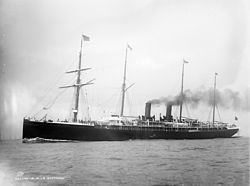La Brittany
|
||||||||||||||||||
|
||||||||||||||||||
|
||||||||||||||||||
|
||||||||||||||||||
The La Bretagne was a transatlantic passenger steamer put into service in 1886 for the French shipping company Compagnie Générale Transatlantique (CGT), which was built for the passenger service from Le Havre to New York . In 1912 it was sold and in December 1923 it ran aground on the North Sea island of Texel on the way to the scrapping yard in the Netherlands .
The ship
The La Bretagne was the second in a series of four new transatlantic liners that the Compagnie Générale Transatlantique put into service in 1886 for transatlantic passenger and mail traffic on the North Atlantic . The other three were the La Champagne with 7,087 GRT, the La Gascogne with 7,071 GRT and the La Bourgogne with 7,395 GRT. The four ships were named after regions of France . The sister ships were furnished by the Paris- based interior designer Jules Allard et Fils, one of the most popular interior designers of his time, who was particularly known for his extravagant fashion design .
The La Bretagne was built at the Compagnie Générale Transatlantique shipyard in Penhoët near Saint-Nazaire for the shipping company of the same name. It was launched on September 9, 1885. The 150.99 meter long and 15.79 meter wide steamship had two chimneys, four masts and a propeller . The ocean liner was powered by a six-cylinder quadruple expansion steam engine that developed 9,000 hp and could accelerate the ship to up to 17.5 knots. On board there was space for 390 passengers in the first, 65 in the second and 600 in the third class.
On August 14, 1886, La Bretagne left Le Havre on its maiden voyage to New York. Between March 25 and December 28, 1895, after nine years of service in Saint-Nazaire, she was extensively overhauled, with two of the masts being removed and new steam engines installed. The third class passenger capacity increased to 1,500 people in the train of the conversions. On June 8, 1912, La Bretagne left Le Havre on its last trip to New York for the CGT. Then she was sold to the Compagnie de Navigation Sud-Atlantique together with her sister ship La Gascogne . Bordeaux was the new port of departure .
In August 1914, due to the war , the La Bretagne was converted into a hospital ship with 550 beds and from October 1916 sailed under the name Bretagne II . It was mainly used in the Mediterranean area. In March 1917 she was struck off the list of hospital ships and on April 4, 1917 she went on a trip as a troop transport to Dakar . On June 8, 1917, she was finally released from military service and disarmed in Bordeaux. In June 1919, La Bretagne was renamed Alésia . In 1923 the ship was sold to Holland for demolition, but ran aground on the West Frisian island of Texel on the way to dismantling around December of the same year and was a total loss .


